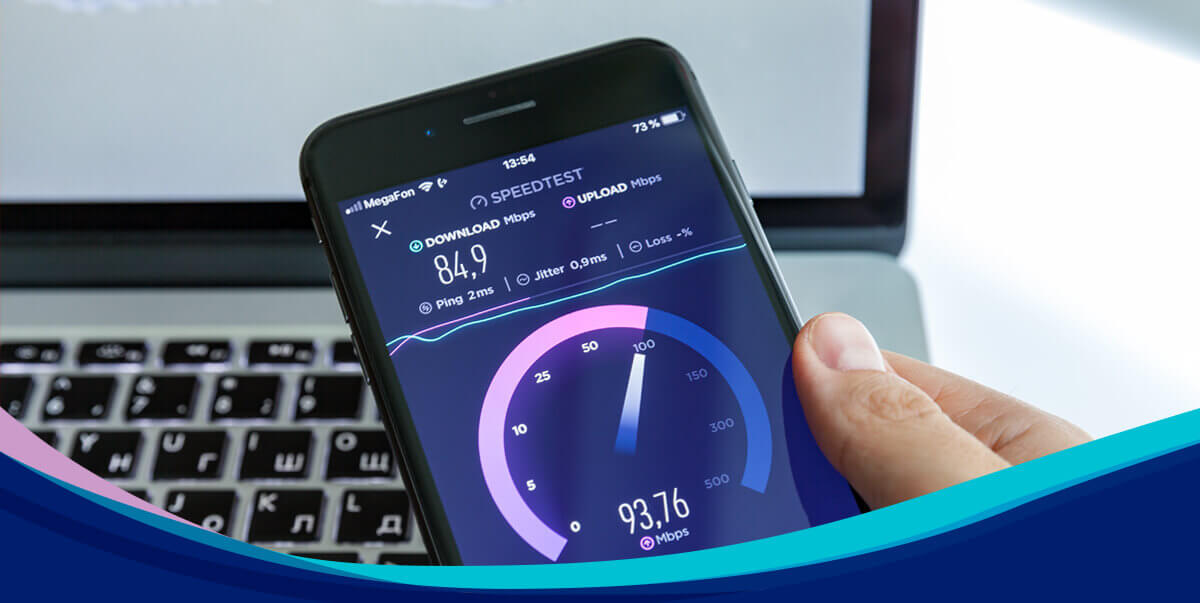Dan Howdle | February 13th, 2024
What is broadband and how does it work?
Once the domain of the tech nerd, broadband (or the internet in general) is something most of us now take for granted. It has become so ingrained in our lives it's widely regarded as a utility like electricity or gas. The internet works away quietly in the background, and so long as it is working as it should, we tend to barely give it a second thought.

What is broadband?
Asking ‘what is broadband’ might seem like an idiotic question. It’s a bit like asking 'What is gravity?' or 'What is electricity?', but really, when you think about it, most of us couldn't provide a satisfactory answer to any of those questions. We tend to think that what a product or service does defines it, instead of what it actually is. What is electricity? Well, it's the stuff that powers your devices, but that's not a good definition.
So, what is broadband then? Well, once upon a time people used to send Morse code telegrams to communicate with each other. The code was a series of dots and dashes, or short beeps and long beeps. The best operators could manage about 20 words per minute. Broadband is not a million miles away from this antique technology; it carries signals made up of code, over lines and through the airwaves, but does so much, much faster.
The 'broad' in broadband refers to the wide range of frequencies the signal can be sent over simultaneously. If you imagine the net result of sending thousands of telegrams via Morse code at the same time, you will understand that the 'broader' the broadband, the faster the information can be transferred. Broadband, then, which evolved from 'dial-up' or 'narrowband' has become the de facto term for fast data delivery via a wide area network.
-
 £50 Bill CreditM125 Fibre Broadband
£50 Bill CreditM125 Fibre Broadband- 132Mb average speed +
- Unlimited usage +
- No phone line
- £50 Bill Credit
- No 2024 Price Rise
£26.50 per month(prices may change during contract)£50 Bill Credit£0 one-off cost18 month contract -
 £70 Gift CardUltrafast Plus
£70 Gift CardUltrafast Plus- 500Mb average speed +
- Unlimited usage +
- PAYG calls
- £70 Gift Card
£33.00 per month(prices may change during contract)£70 Gift Card£5 one-off cost24 month contract -
 M500 Fibre Broadband
M500 Fibre Broadband- 516Mb average speed +
- Unlimited usage +
- No phone line
£33.99 per month(prices may change during contract)£0 one-off cost18 month contract
Types of broadband
Broadband does not exist in one pure form when it comes to the technology behind it. After all, if broadband is merely the transmission of information over many frequencies simultaneously, there are a number of ways to accomplish this from a technology and infrastructure point of view. Cables in the ground, telephone wires spanning poles, through the airwaves via a mobile network, or even from space via a satellite; there are many ways to get online.
Here we will take a brief look at the different technologies used to enable broadband and how they differ from one another.
- ADSL – Uses copper cable telephone lines to deliver a broadband signal. Copper (as opposed to fibre optic) limits the speeds possible, which is why ADSL broadband generally maxes out at around 17Mbps, with an average download speed of 10-11Mbps
- FTTC fibre – Fibre to the cabinet broadband uses a mixture of cable types. Fibre optic (glass core) cables go as far as the cabinet on the street, then copper cabling travels from the communal cabinet to your house. Fibre broadband like this is limited to download speeds of around 75Mbps. FTTC is usually called 'superfast' broadband or some variant, which is looking like an increasingly bad way to describe the slowest broadband generally sold these days
- FTTP fibre – Usually called 'Full Fibre', Fibre to the premises (FTTP) uses fibre optic cables for 100% of the network, so the fibre optic connection reaches directly into your home, instead of connecting via copper. This enables much faster speeds than FTTC fibre. FTTP fibre commonly offers speeds of up to 1000Mbps (1Gbps), but can reach as high as 10Gbps from a technology perspective. It's currently available to only a quarter of UK households
- Cable broadband (Virgin Media only) – Virgin Media has its own network and uses a unique coaxial cable that mixes fibre optic glass with copper and other materials. It is partly fibre, but partly not, leading it to be classified as 'Cable Broadband'. Virgin Media's Gig1 package runs at 1130Mbps, which is quite close to the fastest the technology can manage
- 4G/5G broadband – Is actually fibre broadband for most of the journey around the network (to the mast). Then from the mast to your mobile, tablet, MiFi device or 4G/5G home router, the signal is delivered over the airwaves. Some 5G packages can deliver data with speeds of up to 300-500Mbps
- Satellite broadband – Is delivered from space to a satellite dish on your house. It's not particularly fast, maxing out at about 75Mbps. It's also expensive and suffers horribly from latency. It is considered a last resort for those who live too remotely to get fast connectivity by any other means
- Site to site – The rarest of all broadband breeds, site to site is where a transmitter is set up in a central location, usually in a village, usually on its highest structure, which is usually a church spire. A receiver is then placed on the side of your home pointing at it. Very few locations in the UK offer this type of broadband
- Cable broadband (Virgin Media) – Virgin Media has its own network and uses a unique coaxial cable that mixes fibre optic glass with copper and other materials. It is partly fibre, but partly not, leading it to be classified as 'Cable Broadband'. Virgin Media's Gig1 package runs at 1130Mbps, which is quite close to the fastest the technology can manage
Not ready to switch?
We'll remind you when it's time
Use our switching reminder and we'll email you when your deal is coming to an end so you don't lose out!
Set reminderDownloads, uploads and megabits
If you've never had to choose a broadband deal, or simply never given much thought to what the various specifications actually mean, this is the section for you. What, after all, is a megabit exactly, and how on Earth are you supposed to know how many of them you need?
What are megabits?
A megabit is a measure of data. Think about your home address, for example. If that were one piece of data, if it were a 'bit', a megabit would be a thousand copies of your address. When looking at a broadband package, the 'Mb' number you see quoted as your expected average speed is a little more than that, though. It really means 'megabits per second', or Mbps.
Shortening it this way does add to the confusion somewhat. But just think of it like this: the number of megabits per second is the amount of data you can receive (in the case of download speeds) or send (in the case of upload speeds) in one second. The higher the number, the quicker it will be to do things on the internet, primarily downloading data.
What are download speeds?
The number you will see quoted on a broadband package always applies to download speed. Download speeds apply to how fast you can move data between a remote server (on the internet) and your device (phone, computer, set-top box, whatever). Download speeds are more important than upload speeds because apart from posting a photo on Instagram or Facebook, most of us rarely upload files of any significant size.
What are upload speeds?
Upload speeds are the reverse – they govern how long it will take to move data from your device to a remote server on the internet. For example, 'uploading' a photo to Facebook. We use upload very rarely compared to how frequently we use download, which is why in most cases upload speeds offered in popular broadband packages are a fraction of download speeds.
Available broadband speeds
You can't simply have any speed you desire when choosing a broadband package. You will be limited by what's available in terms of the fastest speed you can get where you live. And you will be limited by the fact that broadband providers offer a range of package 'levels' that you will have to choose between. Here's a breakdown of speeds available, what you can do with them and who offers them. Bear in mind that (especially with the very fast speeds) not all of them are widely available across the UK.
- 10-11Mbps – The common average for an ADSL broadband connection, also known as standard broadband. It's fast enough to stream HD TV and movies to one TV, but not for UHD 4K, and it will likely buckle in a household with multiple users
- 60-76Mbps – Is the upper limit for FTTC fibre broadband packages on the Openreach network. It's enough for larger households, but you’ll struggle if everyone's streaming to different TVs at once or someone in the household is downloading video games constantly
- 24-300Mbps – Is the wide range of speeds available with fibre optic broadband, though actual speeds will vary depending on usage, connection (FTTC or FTTP), peak traffic, and more. This range is known as Superfast broadband and is widely available across the UK from major service providers, though to get the higher end of the range you’ll need FTTP which may not be available in your area just yet. Superfast broadband is more than enough for most households, even busy ones with multiple televisions and users
- 300-900Mbps – Also known as Ultrafast broadband, these insanely fast speeds are probably not necessary for most households, but speeds in this range are readily available from many providers across the UK, including BT, EE, Vodafone, and of course, Virgin Media. If you are a heavy internet user, big on large file sharing, peer to peer gaming, or constantly streaming on multiple devices in HD or UHD, Ultrafast might suit you
- 900Mbps to 1130Mbps – Known as Gigafast or Gigabit broadband, this is the top end of fibre optic broadband speeds currently available in the UK. Only a handful of service providers offer true gigafast speeds, which is 1000Mbps (1Gbps) or above. Virgin Media’s Gig1 Fibre download speeds reach up to 1130Mbps, while Community Fibre offers unimaginably fast speeds of up to 3000Mbps, but only around London. Smaller providers such as Hyperoptic (rarely available), and KCOM (if you happen to live in Hull) also offer gigabit broadband. Other major providers offer what they call Gigabit or Gigafast speeds, but this currently peaks around 900Mbps with full fibre with Openreach providers like BT. No one needs internet this fast, but some of us may want it nonetheless.
- Faster than 1130Mbps – Some small, local providers (altnets) offer broadband speeds of two or even three gigabits per second, but it's a real lottery to live somewhere one operates. Virgin Media meanwhile is currently experimentally rolling out 'Gig2' – its 2Gbps service. It will be a long time before many will be able to get Gig2, or for it to be visible on Virgin Media's website since it doesn't use the same cabling technology that the existing Virgin Media network does
Choosing a broadband provider
Speed is one consideration when looking at broadband as a whole – as a package. But there are other things to consider besides.
Price
Fast broadband is great, but there's no point spending more than you need to. If there are only one or two of you in your household, getting Virgin Media's Gig1 service might mean you have 'the best', but it'll also cost you more than you need to spend. Think about your budget and try to balance that against what you actually need. It'll save you money.
Equipment/router
Broadband providers will supply you a free router when you sign up for their service. This is the device that sends your broadband signal around your home both over cables (should you choose to wire devices directly) and over wifi. But not all routers are created equal, with some (especially those from the more popular providers such as BT, Sky, Virgin Media, TalkTalk and Vodafone) being far more capable than others (such as those often supplied by budget providers).
Signal range is usually the biggest differentiator, so if your home is small – a flat, for example – you can probably get away with a budget router from a budget provider more readily than someone with a five-bedroom detached property. Having said that, a number of providers now offer wifi boosters or wifi mesh systems as optional extras that work with your router to provide a good signal throughout your home.
TV bundles
Do you just want broadband and a phone line? Or do you want a TV package or even a mobile deal bundled in? Many providers offer the whole lot these days and you can save money by bundling all your services into one package. It’s something to consider. You can usually add TV (or a mobile package) later on if you want to, but if you do, your provider may make you sign a brand new contract for the whole lot, including your pre-existing broadband service, committing you to another 18 months.
Contract length
Standard broadband contracts are usually for 18 months, but in some cases you can find contracts of up to two years. Once your contract term begins, you won't be able to leave unless there is a fault your provider can't fix or they raise the price of your package. If you leave early you will have to pay termination fees, which is often the total amount left to pay till the end of the contract. Consider contract length carefully.
Special offers
If you've considered all other factors, this can be the thing that determines your ultimate choice. What extras are they offering for signing up? Providers will often offer you cashback or free gifts for joining, but you'll have to see which providers are offering what on a given day as offers change all the time. It’s also worth bearing in mind that you'll often have to wait up to 90 days into your contract before you can claim your cash or gift.